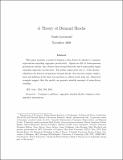| dc.contributor.author | Lorenzoni, Guido | |
| dc.date.accessioned | 2010-02-24T18:28:51Z | |
| dc.date.available | 2010-02-24T18:28:51Z | |
| dc.date.issued | 2009-12 | |
| dc.date.submitted | 2008-11 | |
| dc.identifier.issn | 0002-8282 | |
| dc.identifier.uri | http://hdl.handle.net/1721.1/51815 | |
| dc.description.abstract | This paper presents a model of business cycles driven by shocks to consumer expectations regarding aggregate productivity. Agents are hit by heterogeneous productivity shocks, they observe their own productivity and a noisy public signal regarding aggregate productivity. The public signal gives rise to "noise shocks," which have the features of aggregate demand shocks: they increase output, employment, and inflation in the short run and have no effects in the long run. Numerical examples suggest that the model can generate sizable amounts of noise-driven volatility. | en |
| dc.language.iso | en_US | |
| dc.publisher | American Economic Association | en |
| dc.relation.isversionof | http://dx.doi.org/10.1257/aer.99.5.2050 | en |
| dc.rights | Article is made available in accordance with the publisher's policy and may be subject to US copyright law. Please refer to the publisher's site for terms of use. | en |
| dc.source | author/dept web page | en |
| dc.title | A Theory of Demand Shocks | en |
| dc.type | Article | en |
| dc.identifier.citation | Lorenzoni, Guido 2009. "A Theory of Demand Shocks." American Economic Review, 99(5): 2050–84. | en |
| dc.contributor.department | Massachusetts Institute of Technology. Department of Economics | en_US |
| dc.contributor.approver | Lorenzoni, Guido | |
| dc.contributor.mitauthor | Lorenzoni, Guido | |
| dc.relation.journal | American Economic Review | en |
| dc.eprint.version | Author's final manuscript | |
| dc.type.uri | http://purl.org/eprint/type/SubmittedJournalArticle | en |
| eprint.status | http://purl.org/eprint/status/PeerReviewed | en |
| dspace.orderedauthors | Lorenzoni, Guido | en |
| mit.license | PUBLISHER_POLICY | en |
| mit.metadata.status | Complete | |
